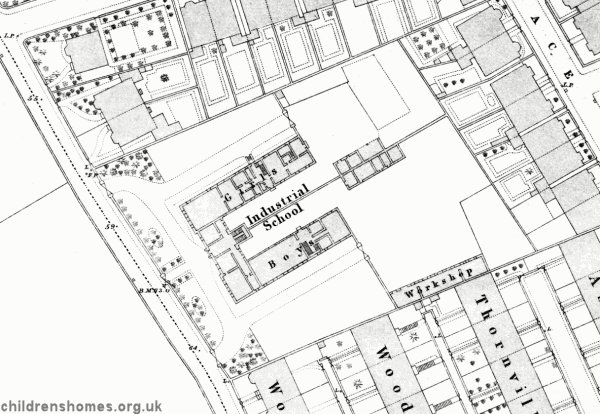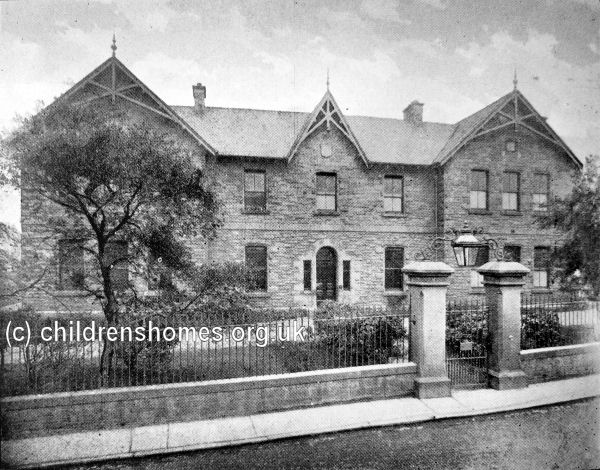Leith Ragged Industrial Schools for Boys and Girls / Industrial School for Boys, Edinburgh, Scotland
On 26 March 1849, a meeting of the inhabitants of Leith adopted measures for the formation of an Industrial School in the town. It was proposed that the school would provide food, education and industrial training, and that the Scriptures would be read daily in the authorised version; children whose parents who objected to the intended religious instruction could still, however, receive the other benefits of the institution.
From 1861, the Leith Ragged Industrial School for Boys and Girls subsequently occupied 24-25 King Street, formerly the premises of the Leith Boys' Charity School, an institution founded in 1805 to educate and clothe orphan children, or those of very poor parents. In its new role, the building could accommodate about 60 children.
The King Street site is shown on the 1850 map below.

Leith Ragged Industrial Schools King Street site, Edinburgh, c.1850.
On 17 January 1862, the establishment was formally accredited as a Certified Industrial School, allowing it to receive children committed by magistrates to a period of detention. An inspection at the end of that year suggested that the premises were too confined and that a larger playground was required with better separation of the boys and girls when out of school. There were 70 children in attendance on the day of inspection, mostly boys, of whom 34 were lodged at the premises, including 22 under detention. There were six girls sleeping at the institution, of whom one was under detention. The superintendent of the school was Mr James Gregor.
In 1867, a large room in an opposite warehouse as hired for working purposes. The boys were instructed in tailoring, shoemaking, and woodcutting. The girls learned needlework, and did the cleaning, washing, and cookery for the school.
The difficulties caused by the school's location and restricted space led its managers to look for a better site. A suitable plot was found at at 57 Lochend Road, Leith, and the foundation stone of the new building was laid on 8 December 1848 by local M.P. Mr R.A. Macfie. The premises were certified for use on 15 September 1869, and formally opened on 26 October.
The new building had a U-shaped layout with a playground occupying the inner area, and a wall separating the girls' section at the north from the boys' section at the south. The front centre of the ground floor was occupied by the master and matron's rooms. In the south wing were the schoolroom, 24 feet by 50 feet, the workrooms for boys, and the janitor's room. In the north wing was the dining hall, 20 feet by 36 feet, the scullery, laundry, and washing-house, etc. The first floor of the building included the committee room, children's dormitories, and work-rooms. The building was designed by Mr Smith of Frederick Street, Edinburgh, and had a total cost of about £6000. Over an acre of ground was attached to the building, partly occupied by worksheds, but mostly used for cultivation, to give gardening and agricultural work for the inmates. The premises could accommodate up to 135 boys and girls, of whom about a hundred slept there. Mr Gregor remained as superintendent, with Miss Crowlie as matron, and Miss E Brunton as assistant teacher. Other staff included a tailor, shoemaker and sewing assistant.
The Lochend Road site is shown on the 1877 map below.

Leith Ragged Industrial Schools Lochend Road site, Edinburgh, c.1877.

Leith Industrial School from the south-west, Lochend Road, Edinburgh, early 1900s. © Peter Higginbotham
At the end of 1878, Mr Gregor was succeeded as superintendent by Mr Andrew Malcolm, with Miss Elizabeth Mackenzie as matron and Miss Isabella Mackenzie as assistant matron. It was reported that twelve of the boys were working as tailors, and eight as shoemakers. Many of the elder boys were occupied as turners and joiners. A large amount of wood-chopping is done, with steam powered machinery being used. The girls were engaged in the housework and laundry work, and made and mended the shirts and clothing,. The younger girls were instructed in knitting and plain sewing.
In mid-1881, Mr. A.S. Nelson took over as superintendent, a post he was to hold for thirty years.
For many years, the school's inspector had been urging that the girls at the school be removed to their own separate premises. This finally took place in 1889 with the opening of a new establishment on Restalrig Road, Leith, which was named the Victoria Industrial School.
An inspection report in 1896 recorded that the boys' classroom performance in matters such as recitation, geography and mental arithmetic was generally good, and that singing was taken once a week. The allocation of boys to the various industrial training occupations was: 12 tailors, 12 shoemakers, 10 wood-turners, 2joiners, 29 firewood makers, 2 van and horse boys, 6 in kitchen, 4 in the laundry, 2 school monitors, 6 house boys and 26 in the brass band. The school had a good gymnasium but no regular instruction was provided. Regular drill took place, however. On Wednesday afternoons in the summer, the boys were taken down to the sea to bathe. They were also allowed out on Saturdays afternoons to go to friends or play football in the Queen's Park or by the sea. There was a good library and boys were allowed to read in their dormitories at night.
Following a steady decline in the number of boys being placed at the school after the First World War, it was closed as of 21 March 1924. The property was later occupied by St Anthony's Secondary Roman Catholic School. The building has now been converted to flats.
Records
Note: many repositories impose a closure period of up to 100 years for records identifying individuals. Before travelling a long distance, always check that the records you want to consult will be available.
- None identfied at present — any information welcome.
Census
Bibliography
- Higginbotham, Peter Children's Homes: A History of Institutional Care for Britain's Young (2017, Pen & Sword)
- Mahood, Linda Policing Gender, Class and Family: Britain, 1850-1940 (1995, Univeristy of Alberta Press)
- Prahms, Wendy Newcastle Ragged and Industrial School (2006, The History Press)
Links
- None noted at present.
Except where indicated, this page () © Peter Higginbotham. Contents may not be reproduced without permission.


